Sydney Philharmonia Choirs. Concert Hall Sydney Opera House. Saturday 29 October, 2022
Reviewed : October, 29, 2022
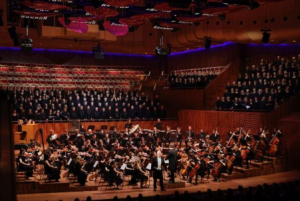
What a sight! Over 350 singers surrounding the stage of the Concert Hall! 93 musicians on the cleverly stepped levels of the stage itself. A packed audience excitedly anticipating the Sydney Philharmonia Choirs’ return to the beautifully renovated Concert Hall.
What better way to celebrate than with the “glorious” music of Giacomo Puccini in a program that juxtaposed his sacred and secular music. In the words of Artistic Director and conductor extraordinaire Brett Weymark, they have brought together a program that reveals “the theatricality of the church and the reverence of the theatre” that that shines through Puccini’s work.
A very special Acknowledgement of Country preceded the work of the Italian maestro. Written by Deborah Cheetham and translated into Gadigal by Matthew Doyle, Tarim Nulaywas – Long Time Living Here was first sung at the Dawn Chorus on the steps of the Opera House at the beginning of 2020 and has become a distinctive part of Sydney Philharmonia performances. Hearing it sung by so many voices and instruments on land that means so much to the indigenous people of the Eora Nation was a fitting spiritual introduction to an inspiring program.
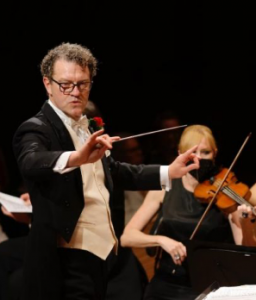
The program began with the Messa di Gloria, Puccini’s Mass for four voices and orchestra, written as he finished his apprenticeship as a student in 1880. Amazing to think that such a complex piece of music, covering so much religious ritual was written by Puccini in his early twenties. Amazing too that it was ‘lost’ to the world until 1950. Celebratory, supplicatory, mysterious, celebratory again, the Gloria gave the Choirs the opportunity to show the beautiful possibilities of voices and orchestra coming together in praise. Joined by critically acclaimed tenor Bradley Daley and much-awarded baritone Peter Coleman-Wright, they told the story of Christ’s short life in glorious, reverential harmony.
It was in Opera that Puccini made his most important mark. Manon Lescaut, La Bohème, Madama Butterfly, Tosca, Turandot – all have been the mainstay of international opera seasons for over a hundred and twenty years. Different to the operas that came before them, Puccini followed Verdi’s idea to write verismo operas, where the themes and characters were more realistic. Some of the best-loved arias – and characters – from his operas were included in this tribute to his “glorious’ work.
From Tosca, the Choirs gave us the triumphant chant of the chorus in the Te Deum in Act 1, with Bradley Daley singing the words of the sinister police chief Baron Scarpia lusting after the fleeing Tosca and planning the death of the escaped prisoner Angelotti. Stirring, impassioned, this was a dramatic opening to the theatricality of Puccini’s verismo operas. What could be more “everyday realism” than jealousy and lust!
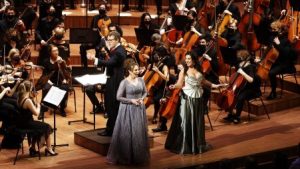
Two of opera’s most popular and accomplished sopranos, Cheryl Baker and Antoinette Halloran, joined the Choirs to share some of the most evocative music from Madama Butterfly, the Flower Duet and the Humming Chorus. Cheryl Baker played the excited Cio-Cio-San, sighting the ship which she believes is bringing her American husband Pinkerton back to her. Antoinette Halloran played her maid Suzuki. Both brought verisimilitude to their roles, showing the longing and elation of the moment that ascends through the music – an elation that is overshadowed by three years of longing and waiting.
From Manon Lescaut, Puccinii’s first major success, the orchestra took the audience, via the Intermezzo between Acts 2 and 3, on the journey of the Chevalier des Grieux’ as he follows his lover Manon to North America. In the program notes, David Garrett describes how the “intermezzo’s big central tune, one of Puccini’s most memorable” finds the des Grieux’ “desperate passion”.
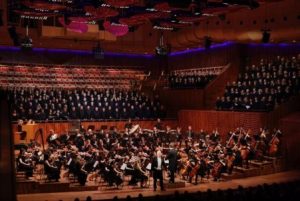
And then to Turandot! From Act 1, we heard the Invocation to the Moon and Prince Calaf imploring Liù not to cry in “Non piangere Liù’. From Act 2 Turandot’s story of her background in ‘In questa reggia’ (In this palace). And lastly, from Act 3 the much loved ‘Nessun dorma’ where Calaf confidently predicts he will follow Turandot’s command that ‘non shall sleep’ … and the very beautiful and touching ‘Tu che di gel sei cinta’ (You who are enclosed in ice). Beautiful because it is Liù’s dying aria, touching because it is also the last music that Puccini wrote.
In this special tribute the Philharmonia Choirs, the soloists and the orchestra celebrated ‘glorious Puccini’. In his 1982 biography Kulian Budden wrote: ” No composer communicates more directly with an audience than Puccini”. That communication was evident in the response of the audience last Saturday night. But it wasn’t just Puccini nor the singers and musicians who made that special ‘direct’ communication …
Brett Weymark has been the driving force behind the Sydney Philharmonia Choirs since 2003. For nearly twenty years his passion for singing and the importance of music to the world has inspired hundreds of music lovers to sing with the Choirs – and to follow their many concerts. It is easy to see why as one sits in the audience watching Weymark at work. He is ‘in’ every moment, every note. His energy and enthusiasm is exciting. It’s evident in the way he holds the baton, the way he almost leaps into stirring moments, the smile as he turns to congratulate his first violin and invites the audience to celebrate the wonderful work of his choristers, soloists and musicians.
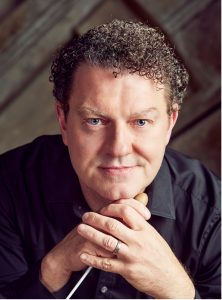
Bravo Brett Weymark! Bravo the Sydney Philharmonia Choirs!
Also published in Stage Whispers magazine.